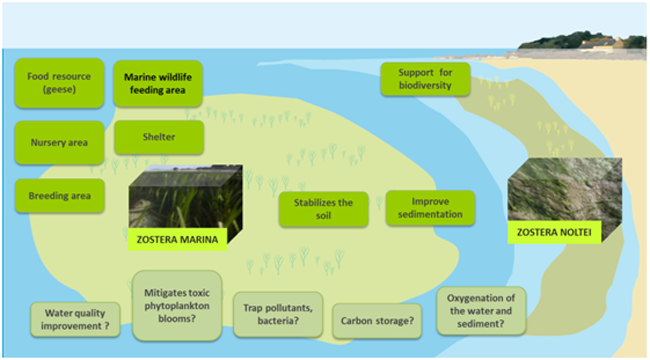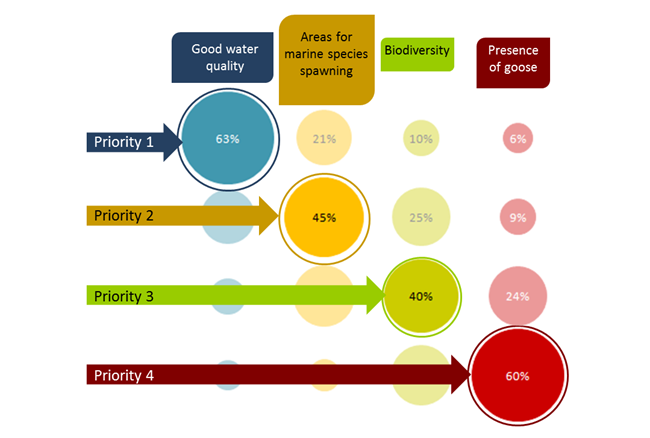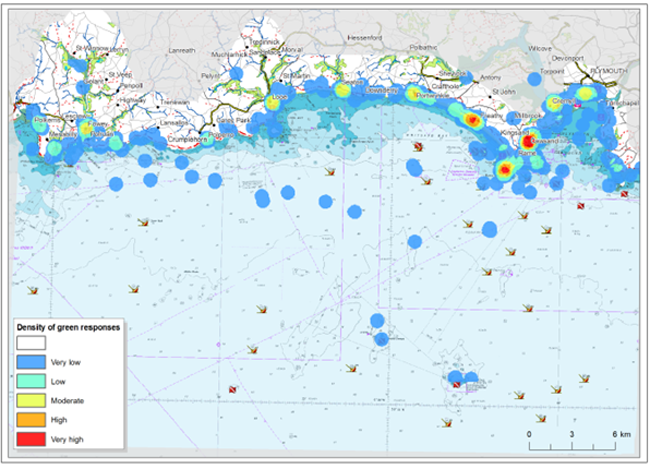3.4.1 Surveys, interviews and focus groups

Surveys, interviews and focus groups are typical social science methods which aim at eliciting preferences of people for a given state of the environment, and provide also useful information on the practices of the stakeholders with regards ecosystems or their perception of the possible changes and main issues to be dealt with by policy-makers.
The Golfe du Morbihan study site used a combination of all the three methods ![]() . In a context of high scientific uncertainty, a series of 50 interviews and 9 focus group workshops was used to gather information regarding the perception of the ecosystem services provided by seagrass beds.
. In a context of high scientific uncertainty, a series of 50 interviews and 9 focus group workshops was used to gather information regarding the perception of the ecosystem services provided by seagrass beds.
 Figure: Functions and services delivered by seagrass beds in the Golfe du Morbihan
Figure: Functions and services delivered by seagrass beds in the Golfe du Morbihan
In addition, a survey was carried out to elicit the preferences of people living in 34 municipalities within the Parc Naturel Régional du Golfe du Morbihan for prioritising policy intervention; the survey concerned 611 respondents who filled a face to face questionnaire in the street. Later on, the same survey included a choice experiment on policy alternatives ![]() .
.
 Figure: Main priorities for policy intervention with respect to the broad categories of ecosystem services delivered by seagrass beds in the Golfe du Morbihan
Figure: Main priorities for policy intervention with respect to the broad categories of ecosystem services delivered by seagrass beds in the Golfe du Morbihan
Over half of the respondents strongly agreed that being in the area helped them to: feel calm and relaxed; clear their head and think; feel closer to nature; and feel refreshed and revitalised.
Survey methods were again used for the Plymouth Sound to Fowey case study in order to investigate the cultural services provided by this part of South East Cornwall [Willis et al., 2014] ![]() . The responses showed a clear link between reported wellbeing and the frequency of visits to the coast: wellbeing was significantly lower for those who ‘almost never’ spend time in/on the sea and at the coast compared to those who spend time there more frequently.
. The responses showed a clear link between reported wellbeing and the frequency of visits to the coast: wellbeing was significantly lower for those who ‘almost never’ spend time in/on the sea and at the coast compared to those who spend time there more frequently.
Respondents were also asked to identify on a map three key areas that were significant or valuable to them (“green dots”), and a further three that they felt were under threat or challenged (“red dots”) and to provide associated narrative details. The information was amalgamated into ‘hotspot’ maps showing the density of green or red dots in particular areas.
The significant and valuable places tended to be particularly associated with history and cultural heritage, childhood memories and family experiences, aesthetic value, recreation and leisure. Places identified as challenged or under threat had poor environmental quality, were at risk of flooding, or had lost their ‘traditional feel’ due to modern developments and second home ownership.

Figure: Significant and valuable places in the Sound to Fowey case study identified by survey respondents

